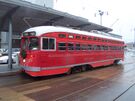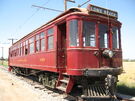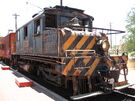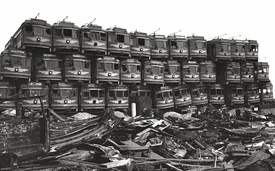
Pacific Electric Railway cars piled atop one another at junkyard on Terminal Island, Calif., 1956 Published caption AWAITING DESTRUCTION--Old Pacific Electric cars are piled up like toys at junkyard on Terminal Island, awaiting dismantling to become scrap metal. Publication Los Angeles Times Publication date March 19, 1956.
Overview[]
The General Motors streetcar conspiracy refers to convictions of General Motors (GM) and other companies for monopolising the sale of buses and supplies to National City Lines and its subsidiaries, and to allegations that this was part of a deliberate plot to purchase and dismantle streetcar systems in many cities in the United States as an attempt to monopolize surface transportation, and to urban legends and other folklore inspired by these events.
Between 1938 and 1950, National City Lines and its subsidiaries, American City Lines and Pacific City Lines—with investment from GM, Firestone Tire, Standard Oil of California through a subsidiary, Federal Engineering, Phillips Petroleum, and Mack Trucks—gained control of additional transit systems in about 25 cities. Systems included St. Louis, Baltimore, Los Angeles, and Oakland. NCL often converted streetcars to bus operations in that period, although electric traction was preserved or expanded in some locations. Other systems, such as San Diego's, were converted by outgrowths of the City Lines. Most companies involved were convicted in 1949 of conspiracy to monopolise interstate commerce in the sale of buses, fuel, and supplies to NCL subsidiaries, but were acquitted of conspiring to monopolize the transit industry.
The story as an urban legend has been studied extensively by Martha Bianco, Scott Bottles, Sy Adler, Robert Post, and Jonathan Richmond. It has been explored several times in print, film and other media, notably in Who Framed Roger Rabbit, Taken for a Ride, and The End of Suburbia.
Only a handful of U.S. cities have surviving effective rail-based urban transport systems based on streetcars, including Newark, Philadelphia, San Francisco, Pittsburgh, New Orleans, and Boston; others are re-introducing them. In many of these cases, the "streetcars" do not actually ride on the street. Boston had all of its downtown lines elevated, or buried, by the mid-1920s, and most of the surviving lines at grade operate on their own right of way. San Francisco and Newark similarly use tunnels.
State wide historical development since 1849[]
In 1849, the Constitutional Convention was first held in Monterey. Among the tasks was a decision on a location for the new state capital. The first legislative sessions were held in San Jose (1850–1851). Subsequent locations included Vallejo (1852–1853), and nearby Benicia (1853–1854); these locations eventually proved to be inadequate as well. The capital has been located in Sacramento since 1854 with only a short break in 1861 when legislative sessions were held in San Francisco due to flooding in Sacramento.
Initially, travel between California and the rest of the continental U.S. was time consuming and dangerous. A more direct connection came in 1869 with the completion of the First Transcontinental Railroad through Donner Pass in the Sierra Nevada mountains. Once completed, hundreds of thousands of U.S. citizens came west, where new Californians were discovering that land in the state, if irrigated during the dry summer months, was extremely well suited to fruit cultivation and agriculture in general. Vast expanses of wheat, other cereal crops, vegetable crops, cotton, and nut and fruit trees were grown (including oranges in Southern California), and the foundation was laid for the state's prodigious agricultural production in the Central Valley and elsewhere.
In the latter half of the 19th century, transit systems were generally rail, first horse-drawn streetcars, and later electric powered streetcars and cable cars. Rail was more comfortable and had less rolling resistance than street traffic on granite block or macadam and horse-drawn streetcars were, in most places, a step up from horsebus: faster, more sanitary, and cheaper to run; electric traction was much more so, with the cost, excreta, epizootic risk, and carcass disposal of horses eliminated entirely. Obsolete streetcars were later seen as obstructions to traffic, but for nearly 20 years they had the highest power-to-weight ratio of anything commonly found on the road, and the lowest rolling resistance.
Migration to California accelerated during the early 20th century with the completion of major transcontinental highways like the Lincoln Highway and Route 66. People thought the state was a place of new opertuneties and a pace to forfill thire dreams. In the period from 1900 to 1965, the population grew from fewer than one million to become the most populous state in the Union. In 1940, the Census Bureau reported California's population as 6.0% Hispanic, 2.4% Asian, and 89.5% non-Hispanic white.
To meet the population's needs, major engineering feats like the California and Los Angeles Aqueducts; the Oroville and Shasta Dams; and the Bay and Golden Gate Bridges were built across the state. The state government also adopted the California Master Plan for Higher Education in 1960 to develop a highly efficient system of public education.
Meanwhile, attracted to the mild Mediterranean climate, cheap land, and the state's wide variety of geography, filmmakers established the studio system in Hollywood in the 1920s. California manufactured 8.7 percent of total United States military armaments produced during World War II, ranking third (behind New York and Michigan) among the 48 states. After World War II, California's economy greatly expanded due to strong aerospace and defense industries, whose size decreased following the end of the Cold War. Stanford University and its Dean of Engineering Frederick Terman began encouraging faculty and graduates to stay in California instead of leaving the state, and develop a high-tech region in the area now known as Silicon Valley. As a result of these efforts, California is regarded as a world center of the entertainment and music industries, of technology, engineering, and the aerospace industry, and as the U.S. center of agricultural production. Just before the "Dot Com Bust" California had the 5th largest economy in the world among nations. Yet since 1991, and starting in the late 1980s in Southern California, California has seen a net loss of domestic migrants most years. This is often referred to by the media as the California exodus.
However, during the 20th century, two great disasters happened in California. The 1906 San Francisco earthquake and 1928 St. Francis Dam flood remain the deadliest in U.S history.
| Year. | Population. |
|---|---|
| 1850 | 3530 |
| 1860 | 11333 |
| 1870 | 15309 |
| 1880 | 33381 |
| 1890 | 101454 |
| 1900 | 170298 |
| 1910 | 504131 |
| 1920 | 936455 |
| 1930 | 2208492 |
| 1940 | 2785643 |
| 1950 | 4151687 |
| 1960 | 6038771 |
| 1970 | 7041980 |
| 1980 | 7477421 |
| 1990 | 8863164 |
| 2000 | 9519338 |
| 2010 | 9818605 |
Background[]
Pre-1918 regional history[]
Streetcars paid ordinary business and property taxes, but also generally paid franchise fees, maintained at least the shared right of way, and provided street sweeping and snow clearance. They were also required to maintain minimal service levels. Many franchise fees were fixed, or were based on the gross, not the net; such arrangements, when combined with fixed fares, were to create impossible financial pressures later. Early electric cars generally had a two-man crew, a holdover from horsecar days, which created financial problems in later years as salaries outpaced revenues.
Many electric lines, especially in the West, were tied into other real estate or transportation enterprises. The Pacific Electric and the Los Angeles Railway were especially so, in essence loss leaders for property development and long haul shipping.
By 1918, long before the actions of any alleged conspirators, half of US streetcar mileage was in bankruptcy.
Conspiracy theorists' alleged early plots[]
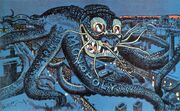
"The Menace of the Hour": the Populist view of transit (1899).
Conspiracy theorists connect Hertz's New York and Chicago bus enterprises with an alleged larger conspiracy. John D. Hertz, better remembered for his car rental business, was also an early motorbus manufacturer and operator. He founded the Chicago Motor Coach Company in 1917 which operated buses in Chicago and the Yellow Coach Manufacturing Company in 1923, a manufacturer of buses. He then formed The Omnibus Corporation in 1926 with "plans embracing the extension of motor coach operation to urban and rural communities in every part of the United States" that then purchased the Fifth Avenue Coach Company in New York. The same year, the Fifth Avenue Coach Company acquired a majority of the stock in the struggling New York Railways Corporation (which had been bankrupted and reorganized at least twice). In 1927 General Motors acquired a controlling share of the Yellow Coach Manufacturing Company and appointed Hertz as a main board director. Hertz's bus lines, however, were not in direct competition with any streetcars, and his core business was the higher-priced "motor coach".
By 1930 most streetcar systems were aging and losing money. Service to the public was suffering; the Great Depression compounded this. Yellow Coach tried to persuade transit companies to replace streetcars with buses, but could not convince the power companies that owned the streetcar operations to motorize. GM decided to form a new subsidiary—United Cities Motor Transport (UCMT)—to finance the conversion of streetcar systems to buses in small cities. The new subsidiary made investments in small transit systems, in Kalamazoo and Saginaw, Michigan and in Springfield, Ohio where they were successful in conversion to buses. UCMT then approached the Portland, Oregon system with a similar proposal. It was censured by the American Transit Association and dissolved in 1935.
The New York Railways Corporation began conversion to buses in 1935, with the new bus services being operated by the New York City Omnibus Corporation, which shared management with The Omnibus Corporation. During this period GM worked with Public Service Transportation in New Jersey to develop the "All-Service Vehicle", a bus also capable of working as a trackless trolley, allowing off-wire passenger collection in areas too lightly populated to pay for wire infrastructure.
Opposition to the so-called 'traction interests' and their influence on politicians was growing. For example, in 1922, New York Supreme Court Justice John Ford came out in favor of William Randolph Hearst, a newspaper magnate, for mayor of New York, complaining that Al Smith, was too close to the 'traction interests'. In 1925, Hearst complained about Smith in a similar way. In the 1941 film Citizen Kane, the lead character, Kane, who was loosely based on Hearst and Samuel Insull, complains about the influence of the 'traction interests'.
The Public Utility Holding Company Act of 1935, which made it illegal for a single private business to both provide public transport and supply electricity to other parties caused great difficulties for the streetcar operators which were frequently also generators of electricity.
National City Lines, Pacific City Lines, American City Lines[]
In 1936 National City Lines (NCL), started in 1920 as a minor bus operation by E. Roy Fitzgerald and his brother, was reorganized "for the purpose of taking over the controlling interest in certain operating companies engaged in city bus transportation and overland bus transportation" with loans from the suppliers and manufacturers. In 1939 Roy Fitzgerald, president of NCL, approached Yellow Coach Manufacturing, requesting additional financing for expansion, and the 1940s, raised funds for expansion from Firestone Tire, Federal Engineering, a subsidiary of Standard Oil of California (now Chevron Corporation), Phillips Petroleum (now part of ConocoPhillips), GM, Mack Trucks (now a subsidiary of Volvo). Pacific City Lines (PCL) also formed as a subsidiary of NCL in 1938, was to purchase streetcar systems in the western United States. PCL merged with NCL in 1948. American City Lines (ACL) which had been organized to acquire local transportation systems in the larger metropolitan areas in various parts of the country in 1943, was merged with NCL in 1946. The federal government investigated some aspects of NCL's financial arrangements in 1941 (which calls into question the conspiracy myths' centrality of Quinby's 1946 letter.) By 1947, NCL owned or controlled 46 systems in 45 cities in 16 states.
From 1939 through 1940, NCL or PCL attempted a hostile takeover of the Key System, which operated electric trains and streetcars in Oakland, California, the attempt was temporarily blocked by a syndicate of Key System insiders, with controlling interest secured on Jan 8, 1941. By 1946, PCL had acquired 64% of the stock in the Key System which operated electric trains and streetcars in Oakland, California.[citation needed]
NCL acquired the Los Angeles Railway (aka the "Yellow Cars") in 1945, which had been in financial trouble for some time.[28] The new owner slowed the closure of streetcar lines and converted others to trackless trolleys, some initially intended for Oakland, others being purchased specifically in 1948. The LATL also bought new PCCs which was one of the last major purchases of new streetcars.
Mr Edwin J. Quinby[]
In 1946, Edwin Jenyss Quinby, an activated reserve commander, founder of the Electric Railroaders' Association in 1934 (which lobbied on behalf of rail users and services), former employee of North Jersey Rapid Transit (which operated in New York) published a 24-page 'expose' on the ownership of National City Lines addressed to "The Mayors; The City Manager; The City Transit Engineer; The members of The Committee on Mass-Transportation and The Tax-Payers and The Riding Citizens of Your Community". It began, "This is an urgent warning to each and every one of you that there is a careful, deliberately planned campaign to swindle you out of your most important and valuable public utilities–your Electric Railway System". His activism may have led Federal authorities to prosecute GM and the other companies.
He also questioned who was behind the creation of the Public Utility Holding Company Act of 1935, which had caused such difficulty for streetcar operations, He was later to write a history of North Jersey Rapid Transit.
Court cases, conviction, and fines[]
On April 9, 1947, nine corporations and seven individuals (officers and directors of certain of the corporate defendants) were indicted in the Federal District Court of Southern California on counts of "conspiring to acquire control of a number of transit companies, forming a transportation monopoly" and "conspiring to monopolize sales of buses and supplies to companies owned by National City Lines" which had been made illegal by the 1890 Sherman Antitrust Act. In 1948, the venue was changed from the Federal District Court of Southern California to the Federal District Court in Northern Illinois following an appeal to the United States Supreme Court (in United States v. National City Lines Inc.) which felt that there was evidence of conspiracy to monopolize the supply of buses and supplies.
In 1949, Firestone Tire, Standard Oil of California, Phillips Petroleum, GM and Mack Trucks were convicted of conspiring to monopolize the sale of buses and related products to local transit companies controlled by NCL; they were acquitted of conspiring to monopolize the ownership of these companies. The verdicts were upheld on appeal in 1951. GM was fined $5,000 and GM treasurer H.C. Grossman was fined $1.
- The trial judge said :
- "I am very frank to admit to counsel that after a very exhaustive review of the entire transcript in this case, and of the exhibits that were offered and received in evidence, that I might not have come to the same conclusion as the jury came to were I trying this case without a jury," explicitly noting that he might not himself have convicted in a bench trial.
The San Diego Electric Railway was sold to Western Transit Company, which was in turn owned by J. L. Haugh in 1948 for $5.5 million. Haugh was also president of the Key System, and later was involved in Metropolitan Coach Line's purchase of the passenger operations of the Pacific Electric Railway. The last San Diego streetcars were converted to buses by 1949. Haugh sold the bus-based San Diego system to the city in 1966.
The Baltimore Streetcar system was purchased by NCL in 1948 and started converting the system to buses. The Pacific Electric Railway's struggling passenger operations were purchased by Metropolitan Coach Lines in 1953 and were taken into public ownership in 1958 after which the last routes were converted to bus operation.
The Urban Mass Transportation Act and 1974 Anti-trust hearings[]
The Urban Mass Transportation Act of 1964 created the Federal Transit Administration with a remit to "conserve and enhance values in existing urban areas" noting that "our national welfare therefore requires the provision of good urban transportation, with the properly balanced use of private vehicles and modern mass transport to help shape as well as serve urban growth." Funding for transit was increased with the Urban Mass Transportation Act of 1970 and further extended by the 1974 National Mass Transportation Assistance Act which allowed funds to support transit operating costs as well as construction costs.
In 1970, Harvard Law student Robert Eldridge Hicks began working on the Ralph Nader Study Group Report on Land Use in California, alleging a wider conspiracy to dismantle U.S. streetcar systems, first published in Politics of Land: Ralph Nader's Study Group Report on Land Use in California.
In 1972 Senator Philip Hart introduced into congress the 'Industrial Reorganization Act', with an intention to restructure the US economy to restore competition and address antitrust concern.
During 1973 Bradford Snell, an attorney with Pillsbury, Madison and Sutro and briefly a former scholar with the Brookings Institution prepared a controversial and disputed paper, titled "American ground transport: a proposal for restructuring the automobile, truck, bus, and rail industries" funded by the Stern Fund which was later described as the centerpiece of the hearings, In it Snell said that General Motors was 'a sovereign economic state' and said that the company played a major role in the displacement of rail and bus transportation by buses and trucks."
This paper was distributed in Senate binding together with an accompanying statement in February 1974, implying that this contents were the considered views of the Senate. The chair of the committee later apologized for this error.[51] Adding to the confusion, Snell had already joined the Senate Judiciary Committee’s Subcommittee on Antitrust and Monopoly as a staff member.
At the hearings in April 1974, San Francisco mayor and antitrust attorney Joseph Alioto testified that "General Motors and the automobile industry generally exhibit a kind of monopoly evil", adding that GM "has carried on a deliberate concerted action with the oil companies and tire companies...for the purpose of destroying a vital form of competition; namely, electric rapid transit". Los Angeles mayor Tom Bradley also testified, saying that GM—through its subsidiaries (namely PCL) "scrapped the Pacific Electric and Los Angeles streetcar systems leaving the electric train system totally destroyed." Neither mayor, nor Snell himself, pointed out that the two cities were major parties to a lawsuit against GM which Snell himself had been "instrumental in bringing"; all had a direct or indirect financial interest. (The lawsuit was eventual dropped, the plaintiffs conceding they had no chance of winning.)
However, George Hilton, a professor of economics at UCLA and noted transit scholar rejected Snell's view, stating,
- "I would argue that these [Snell's] interpretations are not correct, and, further, that they couldn't possibly be correct, because major conversions in society of this character — from rail to free wheel urban transportation, and from steam to diesel railroad propulsion — are the sort of conversions which could come about only as a result of public preferences, technological change, the relative abundance of natural resources, and other impersonal phenomena or influence, rather than the machinations of a monopolist."
GM published a rebuttal the same year titled "The Truth About American Ground Transport." The Senate subcommittee printed GM's work in tandem with Snell's as an appendix to the hearings transcript. GM explicitly did not address the specific allegations that were sub judice.
Role in decline of the streetcars[]
Some say that this played a key role in the decline of public transit in cities across the United States—notably Mr Edwin J. Quinby, who drew attention to NCL's ownership structure in 1946, with mixed results, and later Bradford C. Snell, an assistant attorney for the United States Senate's anti-trust subcommittee, whose 1974 subcommittee testimony brought the issue briefly to national awareness. Mr Quinby and Mr Snell stated that destruction of streetcars systems was integral to a larger strategy to push the United States into automobile dependency. Most transit scholars disagree, suggesting that transit system changes were brought about by other factors; economic, social, and political factors such as unrealistic capitalization, fixed fares during inflation, changes in paving and automotive technology, the Great Depression, anti-trust action, the Public Utility Holding Company Act of 1935, labor unrest, market forces including declining industries' difficulty attracting capital, rapidly increasing traffic congestion, the Good Roads Movement, urban sprawl, tax policies favoring private vehicle ownership, taxation of fixed infrastructure, franchise repair costs for co-located property, wide diffusion of driving skills, automatic transmission buses, and general enthusiasm for the automobile.
- The 1988 film Who Framed Roger Rabbit, vectors the folktale. Scriptwriters Jeffrey Price and Peter S. Seaman explained:
- "the Red Car plot, suburb expansion, urban and political corruption really did happen. In Los Angeles, during the 1940s, car and tire companies teamed up against the Pacific Electric Railway system and bought them out of business. Where the freeway runs in Los Angeles is where the Red Car used to be."
The story was told again in 1996 in Taken for a Ride and then in 2004 in the film The End of Suburbia.
The accuracy of significant elements of Snell's 1974 testimony was challenged in an article published in Transportation Quarterly in 1997 by Cliff Slater.
Recent journalistic revisitings question that the alleged conspirators had a significant impact on the decline of streetcars, suggesting rather that they were setting themselves up to take advantage of the decline as it occurred.
- Guy Span suggested that Snell and others fell into simplistic conspiracy theory thinking, bordering on paranoid delusions stating,
- "Clearly, GM waged a war on electric traction. It was indeed an all out assault, but by no means the single reason for the failure of rapid transit. Also, it is just as clear that actions and inactions by government contributed significantly to the elimination of electric traction."
- In 2010, CBS's Mark Henricks reported:
- "There is no question that a GM-controlled entity called National City Lines did buy a number of municipal trolley car systems. And it's beyond doubt that, before too many years went by, those street car operations were closed down. It's also true that GM was convicted in a post-war trial of conspiring to monopolize the market for transportation equipment and supplies sold to local bus companies. What's not true is that the explanation for these events is a nefarious plot to trade private corporate profits for viable public transportation."
The tram and train firms effected[]
Pacific Electric affairs[]
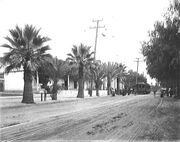
Los Angeles Pacific Railroad Old Mission Trolley streetcar of the Pacific Electric makes a stop at Mission San Gabriel Arcángel, 1905.
Decline[]
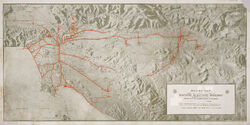
Map of Pacific Electric rail routes, 1920.
The nation's last interurban Railroad post office (RPO) service was operated by PE on its San Bernardino Line.This was inaugurated comparatively late, on September 2, 1947. It left LA's new Union Station interurban yard on the west side of the terminal, turned north onto Alameda Street at 12:45 pm and reached San Bernardino at 4:40 pm, taking three hours for the trip while making postal stops en route as required. It did not operate on Sundays or holidays. This last RPO was pulled off May 6, 1950.
Aware that most new arrivals planned to stay in the region after the war, local municipal governments, Los Angeles County and the state agreed that a massive infrastructure improvement program was necessary. At that time politicians agreed to construct a web of freeways across the region. This was seen as a better solution than a new mass transit system or an upgrade of the PE.
Mr Huntington's involvement with urban rail was intimately tied to his real estate development operations. Real estate development was so lucrative for Huntington and SP that they could use the Red Car as a loss leader. However, by 1920, when most of the company's holdings had been developed, their major income source began to deplete. Many rural passenger lines were unprofitable, with losses offset by revenue generated from passenger lines in populated corridors and from freight operations. The least-used Red Car lines were converted to cheaper bus routes as early as 1925.
In the pre-automobile era, electric interurban rail was the most economical way to connect outlying suburban and exurban parcels to central cities.
Although the railway owned extensive private roadbeds, usually between urban areas, much PE trackage in urban areas such as downtown Los Angeles west of the Los Angeles River was in streets shared with automobiles and trucks. Virtually all street crossings were at-grade, and increasing automobile traffic led to decreasing Red Car speeds on much of its trackage. At its nadir, the busy Santa Monica Boulevard line, which connected Los Angeles to Hollywood and on to Beverly Hills and Santa Monica, had an average speed of 13 miles per hour (21 km/h).
Traffic congestion was of such great concern by the late 1930s that the influential Automobile Club of Southern California engineered an elaborate plan to create an elevated freeway-type Motorway System, a key aspect of which was the dismantling of the streetcar lines, replacing them with buses that could run on both local streets and on the new express roads.
When the freeway system was planned in the 1930s the city planners planned to include interurban tracks in the center margin of each freeway but the plan was never implemented. There was one exception that was within the Ventura Freeway through Cahuenga Pass. The San Fernando Valley line from Hollywood took to the center of the Freeway over the pass and exited at Lankershim Boulevard. When that service was terminated, the freeway was expanded onto the former PE roadbed.
The Whittier & Fullerton line was cut in 1938, Redondo Beach, Newport Beach, Sawtelle via San Vicente, and Riverside in 1940. When the San Bernardino Freeway opened in 1941 but was not yet connected to the Hollywood Freeway, while the "Four Way" overpass was being constructed, westbound car traffic from the SB freeway poured onto downtown streets near the present Union Station. PE's multiple car trains coming and going from Pasadena, Sierra Madre, and Monrovia/Glendora used those same streets the final few miles from private right-of-way to reach the 6th and Main PE terminal and were bogged down within this jammed traffic. Schedules could not be met, plus former patrons were now driving. The San Bernardino line, Pomona branch, Temple City branch via Alhambra's Main St., San Bernardino's Mountain View local to 34th St., Santa Monica Blvd. via Beverly Hills, and all remaining Pasadena local services were all cut in 1941.The Glendale line survived to the early 1950s due to the convenience of a subway into downtown Los Angeles and used the company's only modern equipment, a group of streamlined PCC cars.
PE carried increased passenger loads during World War II, when Los Angeles County's population nearly doubled as war industries concentrated in the region attracting millions of workers. There were several years when the company's income statement showed a profit when gasoline was rationed and much of the populace depended on mass transit. At peak operation toward the end of the war, the PE dispatched over 10,00 trains daily and was a major employer in Southern California. However, the equipment in use was old and suffered from deferred maintenance.
The nation's last interurban Railroad post office (RPO) service was operated by PE on its San Bernardino Line.[28] This was inaugurated comparatively late, on September 2, 1947. It left LA's new Union Station interurban yard on the west side of the terminal, turned north onto Alameda Street at 12:45 pm and reached San Bernardino at 4:40 pm, taking three hours for the trip while making postal stops en route as required. It did not operate on Sundays or holidays. This last RPO was pulled off May 6, 1950.
Aware that most new arrivals planned to stay in the region after the war, local municipal governments, Los Angeles County and the state agreed that a massive infrastructure improvement program was necessary. At that time politicians agreed to construct a web of freeways across the region. This was seen as a better solution than a new mass transit system or an upgrade of the PE.
Freeway construction[]
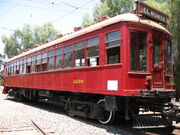
Pacific Electric #1299 Business Car.
Large-scale land acquisition for new freeway construction began in earnest in 1951.[citation needed] The original four freeways of the area, the Hollywood, Arroyo Seco (formerly Pasadena), Harbor, and San Bernardino, were in use or being completed. Partial completion of the San Bernardino Freeway to Aliso Street near downtown Los Angeles led to traffic chaos when inbound automobiles left the freeway and entered city streets.
The Southern District's passenger service to Santa Ana and Baldwin Park ended in 1950 as did the Northern District's Pasadena's Oak Knoll line, and the Sierra Madre line. The Western District's last line to Venice and Santa Monica also ended. The Pasadena and Monrovia/Glendora lines ended in 1951.
The various public agencies—city, county, and state—agreed with PE that further abandoning service was necessary and PE happily complied. PE management had earlier compared costs of refurbishing the Northern District interurban lines to Pasadena, Monrovia/Glendora, and Baldwin Park versus the alternative of converting to buses, and found in favor of the latter.
Remaining PE passenger service was sold off in 1953 to Metropolitan Coach Lines, which was given two years of rent-free usage of rail facilities Jesse Haugh, of Metropolitan Coach Lines was a former executive of Pacific City Lines which together with National City Lines acquired local streetcar systems across the country with the intention of shutting them down and converting them to bus operation in what became known as the Great American Streetcar Scandal.
Several lines operating to the north and the west which used the Belmont Tunnel from the Subway Terminal Building downtown ceased operation – the Hollywood Boulevard and Beverly Hills lines were shut down in 1954 and service to the San Fernando Valley, Burbank and Glendale using newly acquired PCC streetcars lasted only to 1955. The Bellflower line to the south closed in 1958 as the Golden State/Santa Ana (Interstate 5) neared completion.
Public ownership[]
The Los Angeles Metropolitan Transit Authority had been formed in 1951. It was known as the MTA but is unrelated to the current MTA. This agency had been founded to study the possibility of establishing a publicly owned monorail line running north from Long Beach to downtown Los Angeles and then west to Panorama City in the San Fernando Valley. In 1954, the agency's powers were expanded to allow it to propose a more extensive regional mass-transit system and in 1957, its powers were again expanded, this time to allow it to operate transit lines.
In 1958, the California state government through its Public Utility Commission took over the remaining and most popular lines from Metropolitan Coach Lines. The MTA also purchased the remaining streetcar "Yellow Car" lines of the successor of the Los Angeles Railway, then called Los Angeles Transit Lines. LARy/LATL had been purchased from the Huntington estate by National City Lines in 1945.[34] The MTA started operating all lines as a single system on March 3, 1958.
The interurban Los Angeles to Long Beach passenger rail line served the longest, from July 4, 1903, until April 9, 1961. It was both the first and last interurban passenger line of the former PE. It still had long stretches of open country running on private right-of-way. With this closure the final rail link was replaced by the interurban Motor Coach 36f ("F" representing Freeway Flyer) route. This former PE route was the first of the new MTA light rail lines, rebuilt as the dual track Metro Blue Line.
The few remaining trolley-coach routes and narrow gauge streetcar routes of the former Los Angeles Railway "Yellow Cars" were removed in early 1963. The public transportation system continued to operate under the name MTA until the agency was reorganized and relaunched as the Southern California Rapid Transit District in September 1964.[35]
PE's lucrative freight service was continued operation through 1964 under the Pacific Electric name by the Southern Pacific Railroad using diesel-electric locomotives on the heavy-duty PE rail-bed and rails and tripping the iconic "Wig-Wag" crossing signals of the former PE. A Christmas tree lot was operated in the small stub yard at the northwest corner of Willow and Long Beach Blvd. – the stock arrived in and was stored in a steel sided box car until the Christmas trees were prepared for sale – the busy intersection was where dual trackage departed Long Beach Blvd and joined the private right-of-way from Huntington Beach and Seal Beach towards Los Angeles. The crossing signal there was the first installation of the final design of the Magnetic Watchman wigwag crossing signal and crossbucks. Oil tank cars were still shuttled to Signal Hill even as the surface street tracks were torn up from the center of Long Beach Blvd. long after the copper overhead catenary supply wires had been removed. Southern Pacific (now part of Union Pacific) continues to operate freight service utilizing former PE right-of-way.
San Diego Electric Railway affairs[]
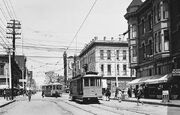
Looking south on Market Street, circa 1904
The first motor buses[]
In 1921 the first motor bus goes into service operating between National City and Chula Vista. "Number One" has hard rubber tires, two-wheel mechanical brakes, a four-cylinder engine, and a plywood body. On March 17, 1923 the SDERy begins its last major rail line expansion to Mission Beach ("Belmont Park"), Pacific Beach, and La Jolla. $2.5 million is spent on rails, Mission Revival Style terminals and substations, and Egyptian Revival Style stations, and $800,000 is spent on the acquisition of 50 new cars. Construction is completed in 1925. Car No. 400, an all-steel model with a closed body and the first on the SDERy to feature a pantograph-type current collector, is delivered in December 1923. All 50 pantograph-equipped cars would eventually have trolley poles installed at each end due to the pantographs' poor performance.
By 1930 buses begin to replace street cars from Ocean Beach to La Jolla, and 222 new buses are added to the fleet. Ridership and revenue decreased but SDERy is able to weather the economic downturn. The 1935 California Pacific International Exposition opens in Balboa Park without the need for expanded transit service. In 1936 SDERy ordered 25 single-end Presidents Conference Committee (P.C.C.) cars from the St. Louis Car Company, and is among the first streetcar systems in the United States to use streamlined units.The cars are designated as Class 6. An order for three additional units is placed the following year.
World War II turns San Diego into a "boom town" again. Defense related industries revitalize the city, as does an influx of military personnel. Ridership on public transit increases 600 percent during the war years. Used transit vehicles are purchased from around the nation, and more electrical power is needed and substations are built (one in the basement of the Spreckels Theatre Building on Broadway). The $2.5 million rail line built in the 1920s to the beaches is ripped out along with the elaborate stations and terminals and replaced with a bus line. By 1942 the combined streetcar and bus lines carry 94 million people. Additional streetcars are brought in on loan from New York City, Salt Lake City, Utah and Wilkes-Barre, Pennsylvania to help keep up with demand. Combined ridership in 1944 lead to more than 146 million trips. An American Red Cross blood donation campaign results in the painting of Cars No. 502 and No. 503 red and blue (in lieu of the standard golden yellow). In 1946 SDERy begins to phase out streetcar lines and replace them with bus routes. By the following year, only three street car lines will remain in operation.
New owners and systematic conversion to buses[]
On July 26, 1948 the Western Transit Company (WTC), owned by Jesse Haugh, bought SDERy for $5.5 million. Haugh was also president of Key System and an executive of Pacific Electric Railway. The following month 13 new 45-passenger buses are placed into service. In September 1948 the WTC announces that the SDERy will henceforth be known as the San Diego Transit System (SDTS). A new emblem (consisting of a pair of wings with a shield in the center) and slogan, "Safety, Courtesy, Service," are adopted. In January 1949 the SDTS borrows $720,000 for the purchase of additional new buses, and makes an application to the State Public Utilities Commission (PUC) to discontinue streetcar service. The PUC grants authority in March 1949 for SDTS to abandon its remaining streetcar lines. Sponsored by the Pacific Railroad Society of Los Angeles, a "farewell to the streetcars" excursion is held, operated over the remaining trackage.
The following month 45 new GM buses (each costing $20,000) parade down Broadway to mark the retirement of the street cars; free rides are offered during the procession. Rail service on the SDERy comes to an end as Car No. 446 pulls into the Adams Avenue car barn, making San Diego the first major Southwestern United States city to eliminate streetcars and convert to an all-bus transit system. In May 1949 work crews begin removing the overhead trolley lines and tracks on the loop at downtown's Union Station. In 1950 17 of the P.C.C. model cars are sold to the El Paso City Lines (EPCL) for service on the international loop between El Paso, Texas, and the Mexican border city of Ciudad Juárez, Chihuahua. A few years later, three more P.C.C.'s are sold to EPCL. All remaining Class 5 cars and the three "service" cars are purchased by the Allied Salvage Company for scrap. The eight remaining P.C.C.'s are purchased in August 1957 by the San Diego Mill Supply Company. Car No. 508 is acquired by the Orange Empire Traction Company for display at its museum in Perris, California, and Car No. 528 is obtained by the San Diego Railway Historical Society for preservation and exhibition.
Los Angeles Railway affairs[]

LARy #863, built in 1912 by the American Car and Foundry Company, is seen here having been retrofitted with steel side panels and folding doors. The unit could carry up to 44 passengers.

A Los Angeles Railway)P Line trolley crossing Alameda Street at 1st Street in Little Tokyo, Los Angeles, as it heads for Boyle Heights in circa 1918.
1898-1944.[]
The system was purchased by railroad and real estate tycoon Henry E. Huntington in 1898 and started operation in 1901. At its height, the system contained over 20 streetcar lines and 1,250 trolleys, most running through the core of Los Angeles and serving such nearby neighborhoods as Echo Park, Westlake, Hancock Park, Exposition Park, West Adams, the Crenshaw district, Vernon, Boyle Heights and Lincoln Heights.
Decline[]
The system was sold in 1945 by Huntington's estate to National City Lines, a company that was purchasing transit systems across the country. National City Lines, along with its investors that included Firestone Tire, Standard Oil of California (now Chevron Corporation) and General Motors, were later convicted of conspiring to monopolize the sale of buses and related products to local transit companies controlled by National City Lines and other companies[n 1] in what became known as the General Motors streetcar conspiracy. National City Lines purchased Key System, which operated streetcars systems in Northern California, the following year.
The company was renamed as Los Angeles Transit Lines. The new company introduced 40 new ACF-Brill trolley buses which had originally been intended for the Key System streetcar system in Oakland which was being converted by National City Lines to buses in late 1948.
Many lines were converted to buses in the late 1940s and early 1950s.
Public ownership and finale[]
The last remaining lines were taken over by the Los Angeles Metropolitan Transit Authority (a predecessor to the current agency, The Los Angeles County Metropolitan Transportation Authority (Metro)) along with the remains of the Pacific Electric Railway in 1958. The agency removed the remaining five streetcar lines (J, P, R, S and V) and two trolley bus lines (2 and 3), replacing electric service with diesel buses on March 31, 1963.
The theorised plan[]
The edged plot[]
It runs on the theory that emergent bus companies and firms who made their buses (mostly GM) were intrinsically bound to compete with the trams and thus had a vested interest in driving them out of business or shutting them down. It is reported by rail enthusiasts, tram lovers and some local business figures at the time that General Motors (GM) and it's allied bus companies were the best at this, especially in southern California. The trams were well used and had popular support, but were economically unvierbal with out state and\or federal government assistance.
Other historical and economic factors[]
Other factors have been cited as reasons for the decline of streetcars and public transport generally in the United States. Robert Post notes that the ultimate reach of GM's alleged conspiracy extended to only about 10% of American transit systems. Guy Span says that actions and inaction by government was one of many contributing factors in the elimination of electric traction. Cliff Slater suggested that the regulatory framework in the USA actually protected the electric streetcars for longer than would have been the case if there was less regulation.
- Some regulations and regulatory changes have been linked to directly to the decline of the streetcars:
- Difficult labor relations, and tight regulation of fares, routes, and schedules took their toll on city streetcar systems.
- The Public Utility Holding Company Act of 1935 prohibited regulated electric utilities from operating unregulated businesses, which included most streetcar lines. The act also placed restrictions on services operating across state lines. Many holding companies operated both streetcars and electric utilities across several states; those that owned both types of businesses were forced to sell off one. Declining streetcar business was often somewhat less valuable than the growing consumer electric business, resulting in many streetcar systems being put up for sale. The independent lines, no longer associated with an electric utility holding company, had to purchase electricity at full price from their former parents, further shaving their already thin margins. The Great Depression then left many streetcar operators short of funds for maintenance and capital improvements.
- The Dual Contracts, signed by the Interborough Rapid Transit Company and Brooklyn–Manhattan Transit Corporation of the New York City Subway, restricted their ability to increase fares at a time of high inflation, allowed the city to take over them, or to operate competing subsidized transit.
- Different funding models have also been highlighted:
- Streetcar lines were built using funds from private investors and were required to pay numerous taxes and dividends. By contrast, new roads were constructed and maintained by the government from tax income.
- By 1916, street railroads nationwide were wearing out their equipment faster than they were replacing it. While operating expenses were generally recovered, money for long-term investment was generally diverted elsewhere.
- The U.S. government responded to the Great Depression with massive subsidies for road construction.
- Later construction of the Interstate Highway System was authorized by the Federal Aid Highway Act of 1956 which approved the expenditure of $25 billion of public money for the creation of a new 41,000 miles (66,000 km) interstate road network Streetcar operators were occasionally required to pay for the reinstatement of their lines following the construction of the freeways.
- Federal fuel taxes, introduced in 1956 were paid into a new Highway Trust Fund which could only fund highway construction (until 1983 when some 10% was diverted into a new Mass Transit Account).
- Other issues which made it harder to operate viable streetcar services include:
- Suburbanisation and urban sprawl, exacerbated in the USA by white flight, created low-density land use patterns which are not easily served by streetcars, or indeed by any public transport, to this day.
- Increased traffic congestion often reduced service speeds and thereby increased their operational costs and made the services less attractive to the remaining users.
- More recently it has been suggested that the provision of free parking facilities at destinations and in the center of cities loads all users with the cost of facilities enjoyed only by motorists, creating additional traffic congestion and significantly affects the viability of other transport modes.
The aftermath[]
Immediate changes[]
A lot more people used cars and busses, so the number of traffic jams rose; but they would have occurred in time as as car usage rose anyhow.
Successors[]
During the 1970s, there was serious discussion about the need for additional mass transit systems based on environmental concerns, increasing population and the 1973 oil crisis. A 1974 inquiry in the Senate heard allegations about the role that General Motors and other companies, including Pacific City Lines, played in the dismantlement of streetcar systems across the U.S. and in particular in Los Angeles in what became known as the Great American Streetcar Scandal. The plot of the 1988 movie Who Framed Roger Rabbit is loosely modeled on the alleged conspiracy to dismantle the streetcar lines in Los Angeles.
In 1976, the state of California formed the Los Angeles County Transportation Commission to coordinate the Southern California Rapid Transit District's (SCRTD, advertised and known locally by Angelinos as the RTD) efforts with those of various municipal transit systems in the area and to take over planning of countywide transportation systems. The SCRTD continued planning of the Metro Rail (Los Angeles County) Subway (the Red Line), while the LACTC developed plans for the light rail system. Construction began in 1985. In 1988, the two agencies formed a third entity under which all rail construction would be consolidated, and in 1993, the SCRTD and the LACTC were merged into the Los Angeles County Metropolitan Transportation Authority (LACMTA).
When the Metro Blue Line commenced commuter service in 1990 from downtown Los Angeles to Long Beach, electric rail passenger train service returned to Los Angeles, using much of the PE roadbed that ceased in 1961. Since then, the LACMTA has opened additional lines.
The Metro Red Line subway opened next in three parts between 1993 and 2000, first from Union Station in central Los Angeles connecting with short subway which forms the northern terminus of Metro Blue Line at 7th/Figuroa Metro Center station, and then west under Wilshire Blvd. onward to Western Avenue. Construction was halted in 1985 due to an unrelated explosion of methane fumes in an underground portion of a Ross Dress for Less store along the proposed route turning north at Fairfax Avenue to Hollywood, which was to service the Los Angeles County Museum of Art, Museum Row and the La Brea Tar Pits. After then-Congressman Henry Waxman banned federal funding for subway construction underneath Wilshire Blvd. past Western Avenue, the subway had to be re-routed. The second portion was the result of this: the subway now traveled north under Vermont Avenue to Hollywood Boulevard turning west to Highland Avenue. When the Hollywood Freeway was built, two PE tracks remained in the center, entering the canyon to Cahuenga Pass under the freeway at what is now the northbound Highland Avenue onramp. PE trackage continued to provide mass transit efficiently until the line was abandoned in 1985; the former roadbed was eventually converted for highway use. RTD bus service replaced rail service and remained the highest daily passenger volume corridor. When the third expansion of the Red Line subway opened, most long distance commuter bus routes from Downtown Los Angeles to the San Fernando Valley were trimmed to connect with the new subway stations, reducing diesel fumes and motor vehicle congestion. It tunnels deep under the Santa Monica Mountains and the next station, at Universal Studios, boasts the world's longest continuous underground escalator. At the northern most Metro Red Line terminus, North Hollywood, connections can be made to several MTA bus routes of the San Fernando Valley, including several routes along the private right-of-way Metro Rapidway Metro Orange Line (route 901) dedicated exclusively for MTA vehicles that replicates many PE thru lines by transferring buses.
The Metro Green Line opened in 1995. Its right-of-way was planned from conception to be entirely isolated and protected, running in the median of Interstate 105, the Century Freeway west from Norwalk, connecting at Rosa Parks Station with Metro Blue Line, then further west to Los Angeles International Airport, and then south on elevated tracks to Redondo Beach. The Century Freeway, named for Century Blvd. the equivalent of 100th St., was the world's first freeway built to bypass and relieve traffic congestion from another freeway – the 91, Artesia Freeway.
The Metro Gold Line opened in 2003, connecting downtown Los Angeles to Pasadena. Mostly at-grade, the line runs along the former Atchison, Topeka & Santa Fe Railroad (AT&SF) historic Super Chief right-of-way, which was converted to dual track overhead electric light rail. California's oldest surviving iron railroad bridge, built across the Arroyo Seco (1895), was also included in the conversion. The Gold Line Eastside Extension now connects Union Station, Downtown Los Angeles toEast Los Angeles. A second extension will extend east from Pasadena, again utilizing the former AT&SF right-of-way in the median of Interstate 210.
Metrolink (Southern California) provides weekday interurban commuters with high speed reversible trains – consisting of Diesel Locomotives hauling double-deck high capacity passenger cars servicing much of Los Angeles County and operating to connections in Ventura County, San Bernardino County, Riverside County, Orange County, and San Diego County as well.
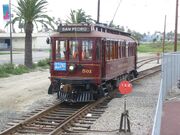
Waterfront Red Car in San Pedro, California. No. #501 PE "Huntington" type wooden streetcar is a replica operated on heritage track. Author: Nkibre Original Uploader WAS Nkibre AT en.wikipedia
The Waterfront Red Car 1.5-mile (2 km) was a streetcar line connecting the World Cruise Center south to Ports O' Call and the 22nd St. terminal, where a shuttle bus connected other attractions along the San Pedro waterfront. Two newly constructed Red Car replicas, #500 & #501, provided service along the line on cruise ship arrival/departure days as well as weekends – Friday, Saturday and Sunday. In addition, a restored 1907-vintage Pacific Electric car, No. #1508 originally rebuilt from two wrecks as a unique motor coach, was available for special rail excursions. It began operation as a tourist attraction on July 19, 2003. The last day of service was on September 27, 2015. The Port of Los Angeles financed, constructed and operated the replica equipment on heritage PE track, one of many of its waterfront revival projects. A new pedestrian esplanade featuring public art and fountains, sculpture and fountains was built alongside the track from the World Cruise Center to the Maritime Museum and Fire Boat Station. It connected to the Cabrillo Marine Aquarium and other San Pedro attractions when using the Waterfront Red Car trolley/shuttle. There were plans to extend the Waterfront Red Car line approximately two more miles south to the Cabrillo Marine Aquarium and the tidepools of Cabrillo Beach, which never came to pass. Plans for an extension of the line north into Wilmington to Avalon Blvd. along existing trackage were discussed as a part of the waterfront improvement plan. These same plans led to this line being discontinued in favor of redevelopment. Some transit advocates proposed linking this line to the Metro Blue Line Long Beach terminus, a very intensive and expensive expansion.
Current usage[]
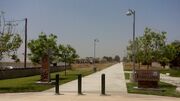
View from Rialto of the Pacific Electric Inland Empire Trail — Fontana, California.
Paths and cycleways[]
The Pacific Electric Trail is a 21-mile rail trail that has been constructed along the former San Bernardino Line. As of March 2013, approximately 18 miles have been completed, from the planned western terminus at Huntington Drive in Claremont ( WikiMiniAtlas34.09528°N 117.70274°W) to the temporary eastern terminus at Maple Avenue in Fontana (34.10138°N 117.40538°W). An additional segment is planned from this point into Rialto, as well as connection to a 6.9-mile rail trail project being planned to run from Claremont to San Dimas.
Revival[]
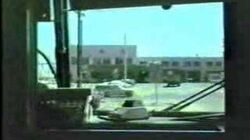
San Diego Trolley in 1985
A look back over 20 years ago at the San Diego Trolley's orginal line and level of service.
San Diego Trolley system[]
After years of planning and development, the "San Diego Trolley" (a new interurban light rail mass transit system) makes its inaugural run on July 19, 1981 on the 15.9-mile (25.6 km) long "South Line" between the U.S. International Border and Centre City San Diego.The following week San Diego Trolley begins revenue service; San Diego will become known in transit circles as "The city that started the 'light rail craze' in the United States".
In August 1996, three "Class 1" streetcars are saved for San Diego. These cars, numbered 126, 128, and 138, were ordered by John Spreckles specifically for San Diego and in anticipation of the 1915 Panama California Exposition. The logo of the SDERy is still visible. The San Diego Historic Site Board recognized the three native "Class 1" streetcars with the official designation of San Diego Landmark #339. In February 2005, the San Diego Electric Railway Association salvaged the body shell of Car No. 357 (formerly of the Bellingham, Washington streetcar system) from a Centre City San Diego restaurant site where it had been used as a "dining room" since 1972.
In December 2005, the San Diego Vintage Trolley Co. purchased three former San Francisco Municipal Railway PCC cars (one numbered 529).[Car No. 529 was later fully restored for public rail service. Three other PCC cars, two from SEPTA and one from New Jersey (531-533), were subsequently purchased. In March 2014, MTS took possession of a second 1946 Presidents Conference Committee (PCC) streetcar, destined to join public service as Car #530. It was estimated that the mostly cosmetic restoration work required to restore Car #530 to service would take six to eight months.
The PCC cars were planned to run on a loop route around Centre City using existing San Diego Trolley tracks. San Diego Metropolitan Transit System, in a partnership with the San Diego historic streetcar society, began select weekday, weekend and holiday mid-day service in August 2011 on this new heritage streetcar Silver Line, which operates around Downtown San Diego using the renovated PCC streetcar #529.
By March 2011 San Diego Metropolitan Transit System began work on a study to evaluate the feasibility of reconnecting Balboa Park, the San Diego Zoo, and Downtown San Diego through a fixed-guideway, electrified streetcar line that might operate as an extension of the Silver Line and might be operated with other restored heritage streetcars.
Restoration in Los Angeles[]
In May 2011, the Los Angeles County Metropolitan Transportation Authority, the city of Los Angeles, and several stakeholders began conducting studies and public meetings to identify the feasibility of restoring streetcar service downtown. The streetcar restoration efforts will further support in revitalizing Downtown Los Angeles's historic core and connect people to employment centers, shopping districts, civic resources, cultural institutions, historic landmarks and entertainment venues within the project study area. A restoration of the streetcar service is anticipated to underscore the overall renaissance occurring in the downtown area of Los Angeles.
The Los Angeles Railway also operated two short, 2 ft 6 in (762 mm) narrow gauge funicular railways: Angels Flight at 3rd Street between Hill and Olive (1901-1969; reopened in 1996 in new location), and the lesser-known Court Flight at Court Street between Broadway and Hill in the Bunker Hill neighborhood.
Court Flight opened in 1905 as part of a business venture by R. E. Blackburn and Samuel G. Vandegrift. It was unusual for funiculars in that it was doubled-tracked for its entire length. The Court Flight Incline Railway ran for a distance of 180 feet up a 42 per cent grade between Broadway and Hill Streets, in the middle of the block between Temple and First Streets. A hotel was planned for the incline, but was never built. After a serious fire, Court Flight was abandoned in 1943 Its site is now part of Grand Park.
Proposed developments[]
More rail lines are in the planning and building stages. Light rail is being designed to connect the city center of San Bernardino with the University of Redlands via the Redlands Subdivision by 2016.
If construction funds are identified, the "Foothill Extension" of the Gold Line will continue with Phase 2 to extend the service to Montclair, or possibly all the way to LA/Ontario International Airport. The line will open to Azusa on March 5, 2016. The Gold Line Foothill Extension Construction Authority has begun plans for Phase 2.
There are several plans in motion to connect the congested West Los Angeles area with rail service. Service has begun on the Expo Line, a light-rail line, as of April 28, 2012 to the intersection of La Cienega and Jefferson; and then as of June 20, 2012, about .8 miles further west, to the corner of National and Washington Boulevards, just east of central Culver City. In 2011 construction began on Phase Two of the Expo Line, continuing from Culver City to Santa Monica, which will open in May 2016.
In 2005, with growing congestion along Wilshire Boulevard to the Westide, then Congressman Henry Waxman introduced legislation to repeal the ban on federal dollars being used for subway tunneling underneath Wilshire Blvd he had passed 20 years earlier. The ban resulted in the Red Line subway ending at Wilshire and Western Avenue before being re-routed up Vermont Avenue towards the Valley. In 2006, the MTA renamed the line from Union Station to Wilshire/Western the Purple Line to differentiate it from the Red Line, which splits at Wilshire/Vermont. As a result, in May 2012, the MTA approved plans to extend the Purple Line to the west as far as the VA Hospital in Westwood, on an alignment mostly following Wilshire Boulevard, the city's most densely populated corridor, as was originally planned in mass transit plans designed as early as the 1920s. In 2005, Mayor Antonio Villaraigosa made as one of his most publicized campaign promises a pledge to set the wheels in motion for eventual construction of the "Subway to the Sea" as he called it. Construction finally began in 2014 on the Purple Line Extension, with the first phase to LaCienega Boulevard scheduled for completion in 2023, and full completion to the VA Hospital campus in West Los Angeles projected for the 2030s, though if additional funding can be found, the subway could be completed earlier.
Also under consideration is a new passenger rail line on the abandoned Harbor Subdivision railway corridor, connecting Carson to downtown Los Angeles via Torrance and the LA west side. Connections to the Harbor Subdivision from the World Cruise Center cruise ship terminal in the San Pedro District of Los Angeles Harbor to the Long Beach Transit Mall and the Metro Blue Line are also under evaluation.
Tourist attractions, monuments and popular culture[]
The 1988 movie Who Framed Roger Rabbit is loosely modeled on the conspiracy to dismantle the streetcar lines in Los Angeles.
In The Simpsons episode titled "Postcards from the Wedge" that aired March 14, 2010 on Fox, the film shown at the beginning of the episode is based on GM's promo films from the 1950s; in addition, the cars from the abandoned Springfield Subway are modeled after the PE cars.
A transportation attraction based on the PE, the Red Car Trolley, is located at Disney California Adventure at the Disneyland Resort in Anaheim. It features two stylized replicas of PE rolling stock and is the first attraction in the park to provide transportation, running from Buena Vista Street to The Twilight Zone Tower of Terror in Hollywood Land, with four stations. Construction began on January 4, 2010, and the attraction opened on June 15, 2012.
Streetcars of the PE are featured as atmospheric elements in L.A. Noire.
Myths and mysteries[]
Some of the specific allegations which have been debunked over the years include:
- According to Snell's testimony, the New York, New Haven and Hartford Railroad in New York was profitable until it was acquired and converted to diesel trains. To begin with, much of the New Haven was never converted to diesel, and remains in electric operation under Amtrak. (Electrified track is also visible from some parts of Snell's Yale campus.) In reality, the line was in financial difficulty for years and filed for bankruptcy in 1935. Ironically, the rail company itself was indicted in 1914 on a charge of "conspiracy to monopolise interstate commerce by acquiring the control of practically all the transportation facilities of New England". Snell made references to these electric trolley and interurban systems briefly controlled by the New Haven as if they were still under their control 40 years later.
- "GM killed the New York street cars". In reality, the New York Railways Company entered receivership in 1919, 6 years before it was bought by the New York Railways Corporation.
- "GM Killed the Red cars in Los Angeles". In reality, Pacific Electric Railway (who operated the 'red cars') was hemorrhaging routes as traffic congestion got much worse with growing prosperity and car ownership levels after the end of World War II, long before 1953.
- The Salt Lake City system is mentioned in the 1949 court papers. However, the city's system was only purchased by National City Lines in 1944 when all but one route had already been withdrawn, and the withdrawal of this last line had been approved three years earlier. (In 1953, Salt Lake City Lines became part of the Utah Transit Authority.)
Images[]
Videos[]
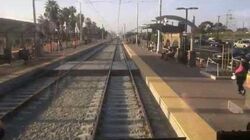
San Diego Trolley cab ride Blue Line-0
A view from behind the cab of a San Diego trolley, one of the old cars. Blue Line, from Iris Avenue to palm Avenue.
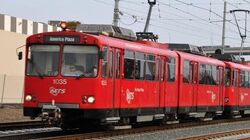
San Diego Trolley Siemens U2 Cars 1981 - 2015
This week, we say goodbye to the Siemens-Duewag U2 trolley cars that for so many years were the face of modern light rail transportation. The U2 cars were the first to be delivered to San Diego in the 1980's and served the city for many years. On January 26th, 2015, they were all officially retired. This video chronicles their years in service, starting in December of 2002 (also the first train I ever filmed) and continuing through almost every year since. The video ends with some clips from late January of 2015, as the new low floor cars replace the U2 cars on the Blue Line. You will see what was probably the last set of U2 cars in service, as they return to downtown San Diego from San Ysidro for the last time.

MTS San Diego Trolley サンディエゴ・トロリー
Tram of San Diego in Southern California, near the Mexican border. The light rail serves on route from 53.5 miles (86.1 km), and three lines (Blue Line, Orange Line, and Green Line).
Also see[]
Sources[]
- http://www.sdera.org/
- https://www.wikiwand.com/en/California
- http://www.thefullwiki.org/Pacific_Electric_Railway
- http://en.citizendium.org/wiki/San_Diego_Electric_Railway
- http://www.digplanet.com/wiki/San_Diego_Electric_Railway
- http://www.wow.com/wiki/San_Diego_Electric_Railway
- http://www.lovearth.net/gmdeliberatelydestroyed.htm
- https://en.wikipedia.org/wiki/San_Diego_Electric_Railway
- https://en.wikipedia.org/wiki/General_Motors_streetcar_conspiracy
- http://99percentinvisible.org/episode/episode-70-the-great-red-car-conspiracy/the
- https://en.wikipedia.org/wiki/Pacific_Electric
- http://www.scpr.org/programs/take-two/2013/03/29/31101/the-great-red-car-conspiracy-of-los-angeles/
- http://framework.latimes.com/2013/03/11/los-angeles-pacific-electric-red-cars/#/0
- http://99percentinvisible.org/episode/episode-70-the-great-red-car-conspiracy/
- http://framework.latimes.com/2013/03/11/los-angeles-pacific-electric-red-cars/#/0
- https://en.wikipedia.org/wiki/San_Diego_Electric_Railway
- https://en.wikipedia.org/wiki/Pacific_Electric
- http://www.railroad.net/articles/columns/reviews/larailway/index.php
- http://search.proquest.com/docview/168255116/
- https://en.wikipedia.org/wiki/San_Diego_Electric_Railway?oldformat=true
- https://www.wikiwand.com/en/San_Diego_Electric_Railway
- http://www.ornl.gov/sci/ees/etsd/pes/pubs/ferc_Meta-R-320.pdf
- http://www.lacounty.gov/
- https://lavote.net/
- http://assessor.co.la.ca.us/extranet/default.aspx
- https://www.wikiwand.com/en/Los_Angeles_County,_California
- https://www.wikiwand.com/en/Los_Angeles
